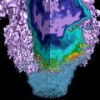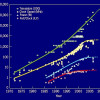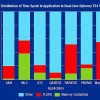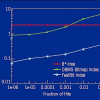News Archive
Berkeley Lab Scientists' Computer Code Gives Astrophysicists First Full Simulation of Star's Final Hours
BERKELEY, CA — The precise conditions inside a white dwarf star in the hours leading up to its explosive end as a Type Ia supernova are one of the mysteries confronting astrophysicists studying these massive stellar explosions. But now, a team of researchers, composed of three applied mathematicians at the U.S. Department of Energy's (DOE) Lawrence Berkeley National Laboratory and two astrophysicists, has created the first full-star simulation of the hours preceding the largest thermonuclear explosions in the universe. Read More »
ESnet Honored as One of Top 10 Government IT Innovators
BERKELEY, CA — Once a year, InformationWeek magazine honors the most innovative players in the field of information technology, including the top 10 government agency innovators. And on Sept. 14, the U.S. Department of Energy’s (DOE) Energy Sciences Network (ESnet) was recognized as a member of this select group for its work helping thousands of researchers worldwide manage the massive amounts of scientific data stemming from the application of petascale supercomputers and high-precision instruments to cutting-edge disciplines such as climate science, high energy physics, astrophysics and genomics. Read More »
Flame simulations lift combustion energy’s future
Gasifying coal to produce hydrogen and other synthetic fuels is an ambitious project in its own right. But DOE’s Office of Fossil Energy (FE) is taking the process a step further with the FutureGen power plant project, which seeks near-zero-emissions combustion technology that not only produces fuel but also sequesters carbon dioxide the process generates. Read More »
Divide and Conquer for TRACTABLE Computations
Nanotechnology holds a wealth of potential for major advances in a broad range of energy applications, but developing nanosystems is quite challenging because simulations necessary to understand structures at the nanoscale require tremendous amounts of computational resources. A new algorithm promises to unleash the power of nanotechnology by enabling electronic structure calculations with hundreds of thousands of atoms. Read More »
The MANYCORE Revolution: Will HPC LEAD or FOLLOW?
Rumors of the death of Moore’s Law are greatly exaggerated, according to a team of computer scientists from Lawrence Berkeley National Laboratory (LBNL) and the University of California (UC)–Berkeley. In their view, Gordon Moore’s observation that the amount of computing power packed onto a chip doubles about every 18 months while the cost remains flat is alive and well. But the physics is changing.
Read More »
The Challenge of Energy-Efficient HPC
The electrical power demands of ultrascale computers threaten to limit the future growth of computational science. To reach exascale computing cost-effectively, a group of researchers propose to radically change the relationship between machines and applications by developing a tightly-coupled hardware/software co-design process. The Green Flash project is intended to dramatically accelerate the development cycle for exascale systems while decreasing the power requirements. Read More »
A Lightning-Fast INDEX Drives Massive DATA Analysis
FastBit is an extremely efficient indexing technology for accelerating database queries on massive datasets. FastBit enhances conventional bitmap indexing technology by employing advanced compression, encoding, and binning methods. Previously, bitmap indexes were only considered useful for categorical data with a small number of possible values. Now, many applications (especially scientific applications) require indexing over data with a very large number of possible values. Because of specialized enhancements, FastBit is fast enough to support real-time queries for scientific data exploration applications, such as visual analytics. In many applications, FastBit can search data 10–100 times faster than other products. Read More »
Berkeley Lab Researchers Receive Recovery Act Funds to Help Improve Reliability of Electrical Grid
BERKELEY, CA– The Lawrence Berkeley National Laboratory (Berkely Lab) announced today that mathematicians from its Computational Research Division (CRD) are receiving Recovery Act funds to help increase the reliability of the electrical grid and improve the nation's ability to respond to energy disruptions. By advancing the technologies needed to implement a smart grid, Berkeley researchers will play an important role in avoiding costly, cascading blackouts like the August 2003 blackout that… Read More »
CRD Receives Funding to Develop Tools for Science Research
In the next few months, researchers from the Lawrence Berkeley National Laboratory's Computational Research Division (CRD) will receive funding to develop tools that will help facilitate science breakthroughs in a variety of disciplines from astrophysics to geology and beyond. Read More »
Code controls communication to boost computer performance
As high-performance computers bring more power to programmers, communication often limits an operation’s overall speed. Read More »







 Instagram
Instagram YouTube
YouTube







